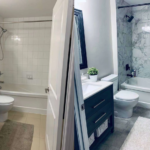Everyone shares a common conception of what a welcoming home looks and feels like. However, even individuals with the clearest vision of a dream home often struggle to turn their desire into a reality. Let’s face it, we have all walked into houses that are far below the bar when it comes to attractive.
There’s the pack rat’s nest, bursting at the seams with meaningless trinkets, worn-out furniture, and sky-high heaps of unframed postcards and magazine catalogs from decades gone by. You may have also encountered the millennial minimalist with nothing but a used air mattress and a cell phone charger in a vacant studio apartment that echoes constantly, even when you whisper.
There’s a right way and a wrong way to do anything. When it comes to interior design, the same principle applies. While there is a plethora of different kinds of interior design layouts, there are certain aspects of design that stay constant, no matter what course you take when it comes to your personal taste.
This article summarizes five helpful techniques for enhancing the attractiveness and uniqueness of your home, no matter who you are or where you live.
Don’t be afraid to innovate
While the design of your home might not happen to be the subject of a series on HGTV, you should design your interior to be something that pleases you, first and foremost. Regardless of how often you host social gatherings in your home, you deserve a place that appeals to your own sense of the aesthetic.
That being said, remember that your vision does not have to follow a long lineage of design tradition. Don’t shrink away from being the creative genius you were born to be. Remember, when it comes to the interior design of your home, you are the ultimate authority.
Innovation in design establishes a sense of personal pride and value. You can express your personality by selecting specific color schemes for different rooms and by buying fine art and complementary decorum as complements.
Of course, you do not have to go purely modern to be unique and innovative. Many designers suggest using a balance of old and new when it comes to furniture and décor. Well placed antiques and cherished family heirlooms will add a wonderful link to the past in any modern home.
Use different media for fine art pieces and décor
There are many eye-catching alternatives to the standard fine art prints on paper. Eyes on Walls, professional art and interior design agency, suggests incorporating artwork printed on alternative surface materials, such as metal or canvas. They suggest canvas as a medium that gives off a more classic vibe and realistic quality.
Eyes on Walls also points out how fine art metal prints are not only great at grabbing attention, but they are durable and resistant to damage from sunlight and adverse conditions.
In addition, you may consider other mediums of art, such as wood, glass, and ceramic. You might even choose natural or artificial potted plants. If you are looking for natural plants that do not require as much care and maintenance, consider miniature cactus or succulents.
Think multi-functional furniture and storage
Most of the time when we think of furniture, we usually think in terms of a single, obvious purpose. It goes without saying that a sofa offers a place to sit and relax, an ottoman provides a place to rest your feet, and a dining table is the designated spot for meals.
Yet, those wanting a more efficient lifestyle should adopt the mindset of multi-functionality. Besides serving its primary purpose, multi-functional furniture can also be used as a storage unit.
Most ottoman footrests and coffee tables contain discreet caches for whatever needs storing. Some tables come with a hollow pillar that not only supports the table, but also contains room for storage.
There are many options out there, so definitely do your research. If anything, keep in mind that shelving, cabinets, and storage units will make all the difference in the organization in your home.
Maintainability
Once you have designed your dream home and it is all finished according to plan, you will want to make sure you can maintain the quality of your home for your own comfort, as well as the comfort of others.
With tidiness comes a sense of pride and welcome, but with clutter comes anxiety and agitation. When selecting furniture and décor, you will need to make considerations for cleaning and care.
Create a checkoff list for routine chores, such as vacuuming carpeting and rugs, dusting furniture, waxing the floor, or watering plants.
There are a few options for low maintenance interior design. The top low maintenance recommendations made by Houzz website include stain-resistant upholstery fabrics, removable stain-resistant carpet tiles, and a central vacuum system with wall inlets that suck in nearby debris.
Gain experience
Overall, one of the best options for creating a more attractive is to gain experience in the field of interior design. This may be done in a variety of ways. You might sign up for classes in interior design at a local community college or university, or you might conduct self-study using literature and online resources.
After initial education, you might wish to further your experience by working an internship for an interior design company. The possibilities when it comes to the experience you gain and what you do with it are really limitless. Enjoy your newfound experience and hobby.
Conclusion:
A welcoming home should contain a balance of structured organization and innovative creativity. You could also think of it as a balance of utility and aesthetic.
Whatever you do, remember that your home is a home for you and your family. Don’t let the criticism of others affect your design decisions. There is a solution for everything in the world of design. When obstacles arise, use your available connections and resources to rise and overcome. No one can judge you for asking questions.
If your home fills you with a sense of contentment and dignity, chances are your family and guests will respond to the atmosphere with the same kind of satisfaction.











